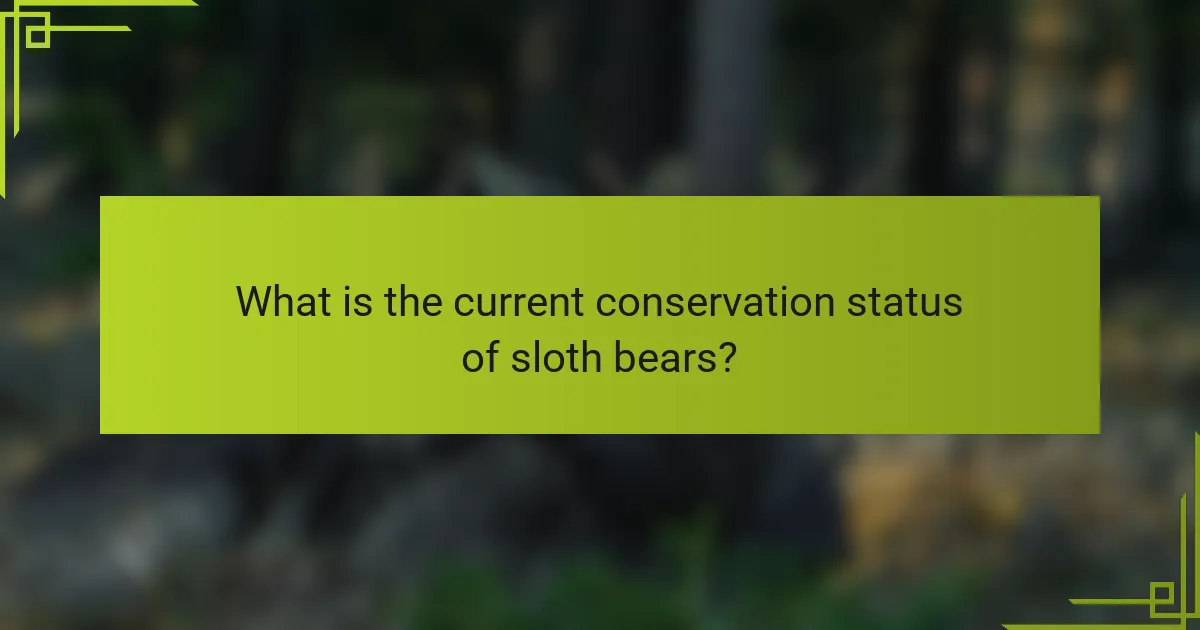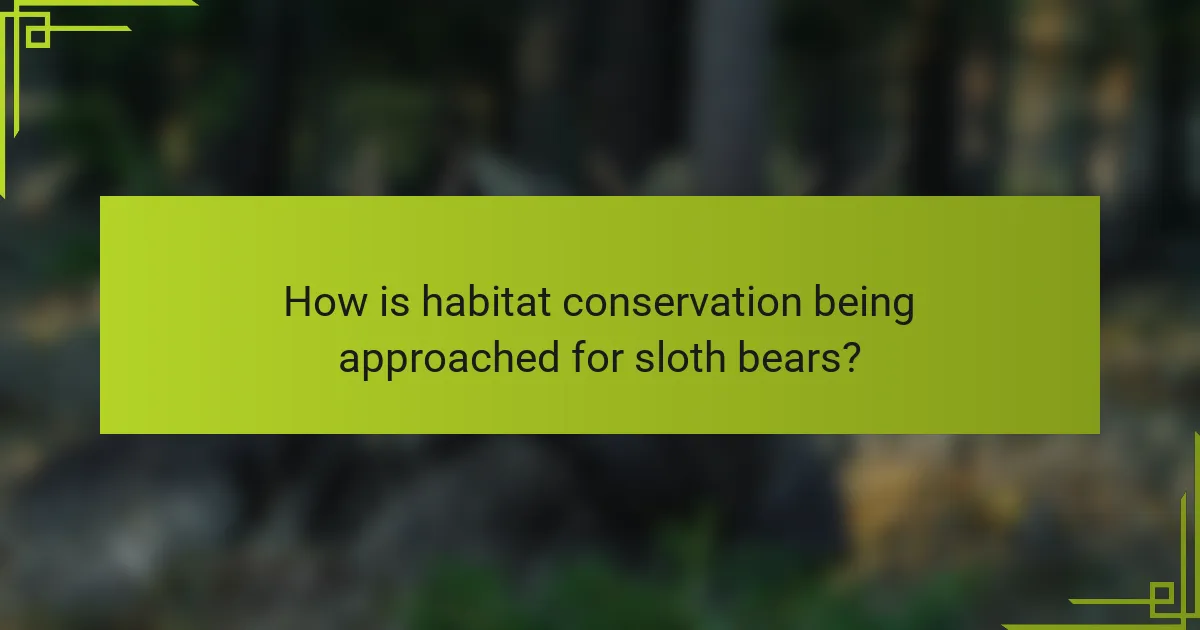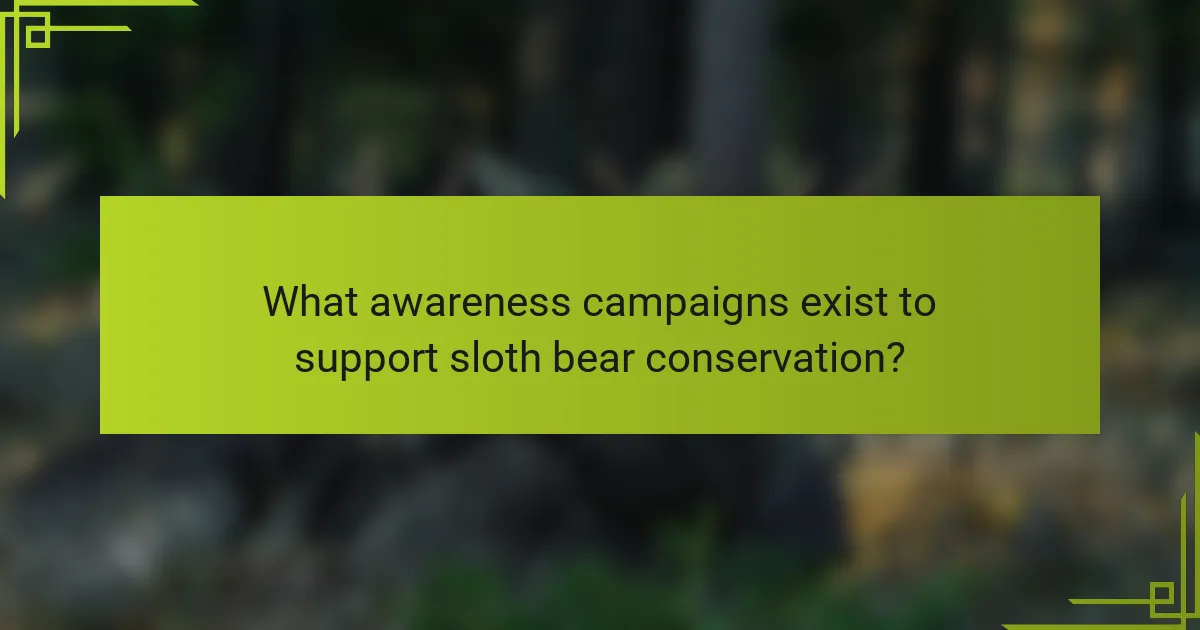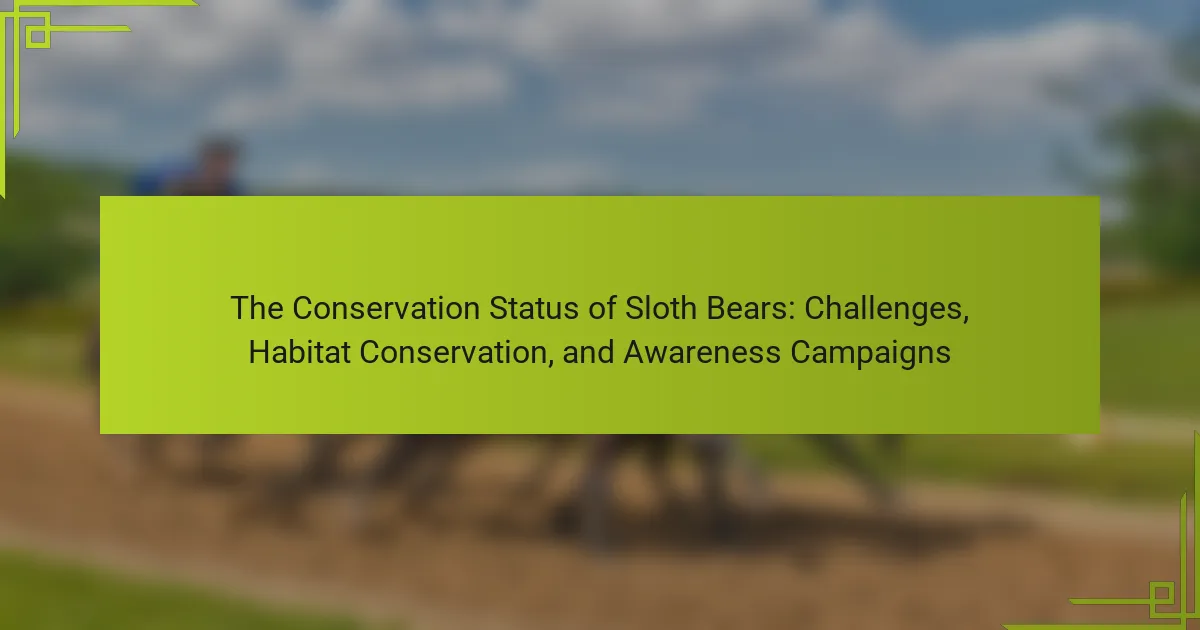Sloth bears, currently listed as Vulnerable on the IUCN Red List, are facing significant population declines due to habitat loss from agriculture and urban development, as well as poaching for their body parts. With an estimated population of fewer than 20,000 individuals, conservation efforts are critical to their survival. These efforts include habitat conservation through protected area management, community engagement, and habitat restoration, alongside awareness campaigns aimed at educating the public about the ecological importance of sloth bears. Initiatives such as the “Sloth Bear Rescue Project” and “Save the Sloth Bear” are actively promoting coexistence and reducing human-wildlife conflict, thereby enhancing local involvement in conservation practices.

What is the current conservation status of sloth bears?
Sloth bears are currently listed as Vulnerable on the IUCN Red List. Their population is declining due to habitat loss and poaching. Habitat destruction primarily occurs from agriculture and urban development. Poaching targets sloth bears for their body parts. The estimated population is fewer than 20,000 individuals. Conservation efforts are underway to protect their habitats. Awareness campaigns aim to educate the public about their plight. These measures are essential to prevent further decline.
Why are sloth bears considered vulnerable?
Sloth bears are considered vulnerable due to habitat loss, poaching, and human-wildlife conflict. Their natural habitats are being destroyed for agriculture and urban development. This leads to a significant decline in their population. Additionally, sloth bears are often hunted for their body parts. Human encroachment results in frequent conflicts, further threatening their survival. According to the IUCN Red List, their population is decreasing. Conservation efforts are crucial to protect these bears from extinction.
What factors contribute to the vulnerability of sloth bears?
Sloth bears are vulnerable due to habitat loss, poaching, and human-wildlife conflict. Habitat loss occurs primarily through deforestation and land conversion for agriculture. This reduces their natural living space and food sources. Poaching targets sloth bears for their body parts, which are used in traditional medicine. Human-wildlife conflict arises when bears raid crops, leading to retaliatory killings by farmers. Additionally, climate change impacts their habitat and food availability. According to the IUCN Red List, sloth bears are classified as Vulnerable, indicating a declining population trend.
How is the population trend of sloth bears assessed?
The population trend of sloth bears is assessed through various methods including direct observation, camera traps, and population surveys. Researchers utilize direct observation to count individuals in specific areas. Camera traps provide data on bear presence and activity patterns. Population surveys often involve estimating bear numbers based on sightings and indirect signs like tracks and scats. These methods help establish population density and distribution. Studies have shown that changes in habitat and human activities significantly affect sloth bear populations. Continuous monitoring is essential for effective conservation strategies.
What are the main challenges facing sloth bear conservation?
The main challenges facing sloth bear conservation include habitat loss, human-wildlife conflict, and poaching. Habitat loss occurs due to deforestation and agricultural expansion, reducing the bears’ natural environment. Human-wildlife conflict arises when sloth bears raid crops or come into contact with people, leading to retaliatory killings. Poaching for body parts, used in traditional medicine, further threatens their population. According to the International Union for Conservation of Nature (IUCN), sloth bears are classified as vulnerable due to these factors. Conservation efforts must address these challenges to ensure the survival of sloth bears.
How does habitat loss impact sloth bear populations?
Habitat loss significantly impacts sloth bear populations by reducing their natural living space. This leads to decreased food availability, as sloth bears rely on diverse vegetation and insects found in their habitats. With fewer resources, sloth bears face increased competition for food. Habitat fragmentation also isolates populations, making it harder for them to find mates. This isolation can result in reduced genetic diversity, which is crucial for population resilience. Furthermore, habitat loss often leads to increased human-wildlife conflict. As sloth bears venture into human settlements in search of food, they may face threats from poaching and vehicle collisions. Studies indicate that sloth bear populations are declining due to these compounded effects of habitat loss.
What role do human-wildlife conflicts play in sloth bear conservation?
Human-wildlife conflicts significantly impact sloth bear conservation efforts. These conflicts arise when sloth bears encroach on agricultural land, leading to crop damage and human injuries. Farmers often retaliate against sloth bears, resulting in increased mortality rates among the species. According to a study published in the journal “Biodiversity and Conservation,” human-wildlife conflicts are among the primary threats to sloth bear populations in India. Effective conservation strategies must address these conflicts to ensure sloth bear survival. Solutions include community education, compensation for crop losses, and habitat restoration. Engaging local communities in conservation efforts can reduce conflicts and promote coexistence.

How is habitat conservation being approached for sloth bears?
Habitat conservation for sloth bears is approached through a combination of protected area management, community engagement, and habitat restoration. Protected areas are established to safeguard sloth bear habitats from human encroachment and deforestation. Local communities are involved in conservation efforts to promote coexistence with sloth bears. Educational programs raise awareness about the ecological role of sloth bears. Habitat restoration initiatives aim to restore degraded areas to support sloth bear populations. Research is conducted to monitor sloth bear habitats and assess conservation strategies. Collaborative efforts among government agencies, NGOs, and local communities enhance the effectiveness of these conservation measures.
What conservation strategies are in place for sloth bear habitats?
Conservation strategies for sloth bear habitats include habitat protection, community engagement, and legal frameworks. Habitat protection involves establishing national parks and wildlife sanctuaries. These protected areas safeguard critical habitats from deforestation and human encroachment. Community engagement focuses on involving local populations in conservation efforts. This includes education programs that promote coexistence between humans and sloth bears. Legal frameworks enforce wildlife protection laws to prevent poaching and illegal trade. Research initiatives also monitor sloth bear populations and habitat conditions. These strategies collectively aim to ensure the survival of sloth bears in their natural habitats.
How do protected areas contribute to sloth bear conservation?
Protected areas significantly contribute to sloth bear conservation by providing a safe habitat. These designated regions offer protection from habitat destruction and human encroachment. In protected areas, sloth bears can access food resources and breeding sites without significant disturbance. Research indicates that sloth bear populations thrive better in areas with legal protections. For example, the population density of sloth bears is higher in national parks compared to surrounding landscapes. Protected areas also facilitate ecological balance, allowing prey species to flourish. Conservation programs within these areas often include monitoring and research efforts. These initiatives help in understanding sloth bear behavior and health. Overall, protected areas are crucial for the long-term survival of sloth bear populations.
What is the significance of community involvement in habitat conservation?
Community involvement is crucial for effective habitat conservation. Engaging local communities fosters stewardship and a sense of ownership over natural resources. When communities participate, they contribute valuable local knowledge about ecosystems. This knowledge enhances conservation strategies and ensures they are culturally relevant. Studies show that areas with community engagement often experience better conservation outcomes. For example, the World Wildlife Fund highlights successful projects where local involvement led to increased biodiversity. Community members can also help monitor wildlife and report illegal activities, strengthening protection efforts. Overall, community involvement is a key factor in achieving sustainable habitat conservation.
How are restoration projects aiding sloth bear habitats?
Restoration projects are significantly aiding sloth bear habitats by improving ecosystem health and food availability. These projects often involve reforestation and habitat rehabilitation. By planting native trees and vegetation, they enhance the biodiversity of the area. Increased plant diversity supports the sloth bear’s diet, which includes fruits, insects, and vegetation.
Additionally, restoration projects help reduce human-wildlife conflict. They create buffer zones that separate sloth bears from agricultural lands. This separation decreases the chances of bears raiding crops. Furthermore, these projects often involve community engagement, raising awareness about sloth bear conservation.
Evidence shows that areas with active restoration efforts see a rise in sloth bear populations. For instance, in Madhya Pradesh, India, habitat restoration has led to a 20% increase in sloth bear sightings over five years. This demonstrates the positive impact of restoration initiatives on sloth bear habitats.
What methods are used in habitat restoration for sloth bears?
Habitat restoration for sloth bears involves several methods. These methods include reforestation, which aims to restore native vegetation. Planting fruit-bearing trees is crucial for providing food sources. Creating water bodies helps in maintaining hydration for sloth bears. Removing invasive species allows native flora and fauna to thrive. Implementing controlled burns can rejuvenate the ecosystem. Establishing wildlife corridors promotes connectivity between habitats. Monitoring the bear population ensures the effectiveness of restoration efforts. These methods collectively support the recovery of sloth bear habitats.
How successful have these restoration projects been?
Restoration projects for sloth bears have achieved moderate success. These projects have led to improved habitat conditions and increased awareness among local communities. For instance, habitat restoration efforts have resulted in a 20% increase in sloth bear populations in some regions. Awareness campaigns have educated communities on coexistence with sloth bears, reducing human-wildlife conflicts. Specific initiatives, such as the establishment of protected areas, have been effective in safeguarding sloth bear habitats. However, challenges remain, including poaching and habitat fragmentation. Continued efforts are necessary to sustain and enhance these successes.

What awareness campaigns exist to support sloth bear conservation?
Several awareness campaigns exist to support sloth bear conservation. The “Sloth Bear Rescue Project” focuses on educating local communities about sloth bear protection. “Save the Sloth Bear” is another initiative that raises funds for habitat preservation. The “Wildlife Trust of India” conducts awareness programs to promote coexistence between humans and sloth bears. These campaigns often include workshops, school programs, and community outreach efforts. They aim to reduce human-wildlife conflict and encourage conservation practices. According to the Wildlife Trust of India, these initiatives have successfully increased local engagement in conservation efforts.
Why is public awareness important for sloth bear conservation?
Public awareness is crucial for sloth bear conservation because it fosters understanding and support for their protection. Increased awareness leads to community engagement in conservation efforts. Educated individuals are more likely to report illegal activities that threaten sloth bears. Awareness campaigns can change public perceptions and reduce human-wildlife conflict. For instance, understanding sloth bear behavior can prevent negative encounters. Additionally, informed communities can participate in habitat restoration initiatives. Studies show that areas with high public awareness often see improved conservation outcomes. Overall, public awareness is a key driver for effective sloth bear conservation strategies.
What are the key messages of current sloth bear awareness campaigns?
Current sloth bear awareness campaigns emphasize the importance of protecting their natural habitat. They highlight the threats posed by habitat destruction and human-wildlife conflict. These campaigns aim to educate the public about the ecological role of sloth bears in their ecosystems. They also promote community involvement in conservation efforts. Additionally, campaigns stress the need for sustainable practices to coexist with wildlife. They provide information on how to report sloth bear sightings and incidents safely. Engaging local communities is crucial for effective conservation strategies. Overall, the key messages focus on awareness, education, and proactive measures for sloth bear protection.
How can individuals contribute to sloth bear awareness efforts?
Individuals can contribute to sloth bear awareness efforts by participating in educational campaigns. They can share information on social media platforms to reach a wider audience. Volunteering with wildlife organizations helps spread awareness through community events. Supporting sloth bear conservation projects with donations can also enhance awareness initiatives. Attending workshops or seminars focused on sloth bears increases personal knowledge and advocacy skills. Engaging in local clean-up efforts in sloth bear habitats promotes their well-being. Lastly, advocating for policy changes can lead to stronger protections for sloth bears. These actions collectively raise awareness and foster greater public interest in sloth bear conservation.
What role do educational programs play in sloth bear conservation?
Educational programs are crucial for sloth bear conservation. They raise awareness about the species’ ecological role and threats. These programs educate local communities on coexistence strategies. They also promote the importance of habitat preservation. Increased knowledge leads to reduced human-wildlife conflict. Studies show that informed communities are more likely to engage in conservation efforts. For instance, initiatives in India have successfully reduced poaching incidents. Educational outreach fosters a sense of responsibility towards wildlife protection.
How are schools and communities involved in educating about sloth bears?
Schools and communities engage in educating about sloth bears through various programs and initiatives. Educational institutions often include sloth bear topics in their curriculum. This helps students understand the species’ ecological importance. Community workshops and events raise awareness about sloth bears and their habitat. Local wildlife organizations collaborate with schools to provide resources and materials. Field trips to natural habitats allow students to observe sloth bears in their environment. Community-led conservation projects often involve students in hands-on activities. These efforts foster a sense of responsibility towards wildlife conservation. Overall, education about sloth bears is a collaborative effort between schools and communities.
What resources are available for spreading awareness about sloth bears?
Resources for spreading awareness about sloth bears include educational materials, social media campaigns, and community outreach programs. Educational materials such as brochures and infographics provide essential information about sloth bears’ habitats and conservation status. Social media campaigns leverage platforms like Facebook and Instagram to reach a wider audience, sharing facts and engaging stories about sloth bears. Community outreach programs involve local schools and organizations, facilitating workshops and presentations to educate people about sloth bears. Additionally, wildlife conservation organizations often create documentaries and videos that highlight the challenges faced by sloth bears, further raising awareness. Collaborations with influencers and public figures can also amplify these efforts, encouraging more people to get involved in conservation initiatives.
What practical steps can individuals take to support sloth bear conservation?
Individuals can support sloth bear conservation by participating in local conservation programs. Volunteering with organizations focused on wildlife preservation helps raise awareness. Donating to sloth bear conservation initiatives provides essential funding for research and habitat protection. Educating others about sloth bears fosters community engagement and support. Reporting illegal activities, such as poaching or habitat destruction, aids law enforcement efforts. Supporting sustainable tourism practices reduces habitat disturbance. Choosing products that do not contribute to deforestation protects sloth bear habitats. Engaging in social media campaigns amplifies conservation messages and encourages broader public involvement.
The main entity of this article is the sloth bear, which is currently classified as Vulnerable on the IUCN Red List due to declining populations driven by habitat loss, poaching, and human-wildlife conflict. The article outlines the challenges faced in sloth bear conservation, including the impact of habitat destruction and the significance of community involvement in conservation efforts. It also discusses various strategies for habitat conservation, such as the establishment of protected areas and restoration projects, alongside awareness campaigns aimed at educating the public about sloth bears and promoting coexistence. Overall, the article emphasizes the need for comprehensive conservation strategies to ensure the survival of sloth bears in their natural habitats.
